
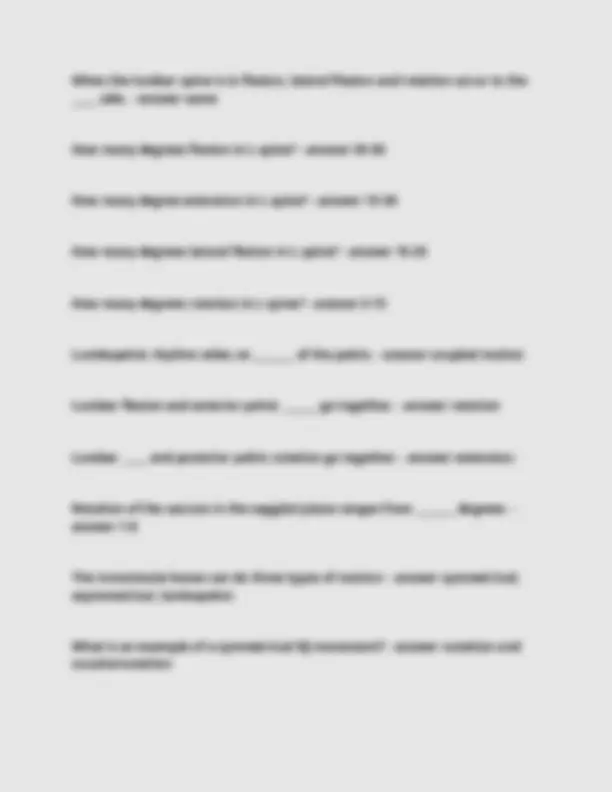
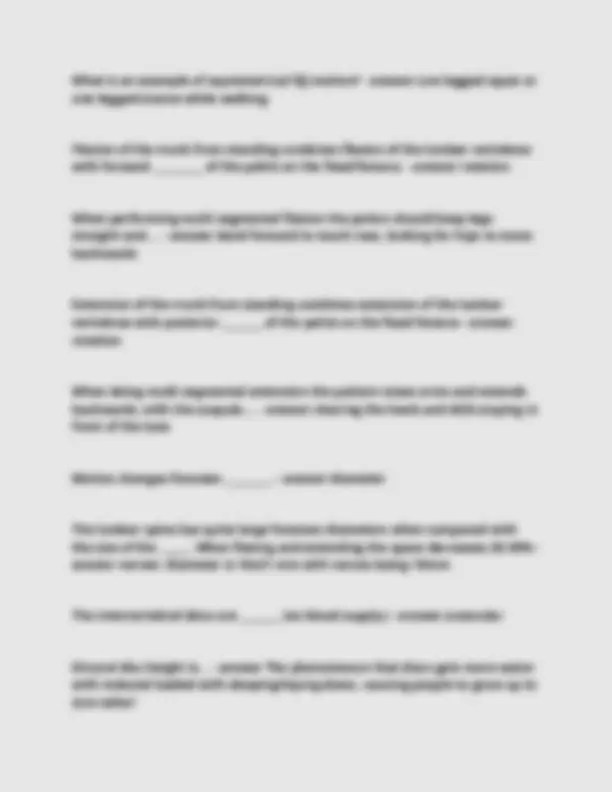
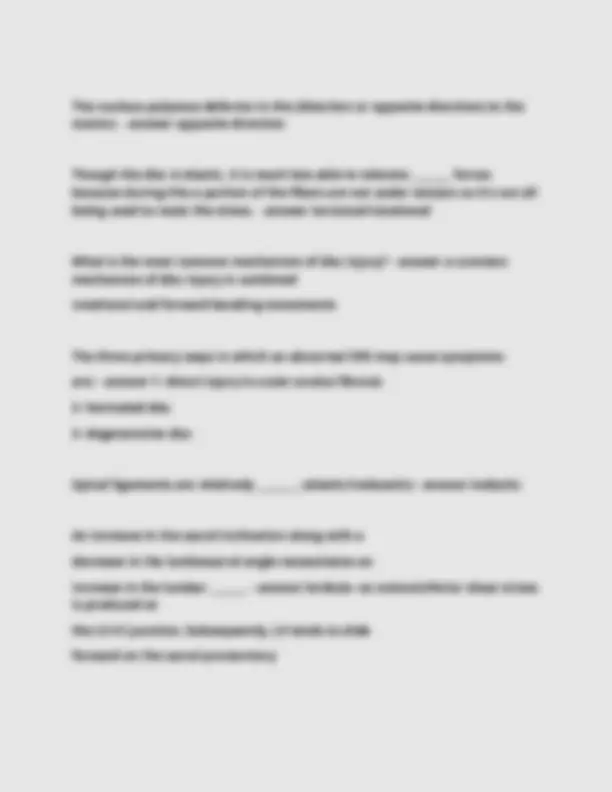
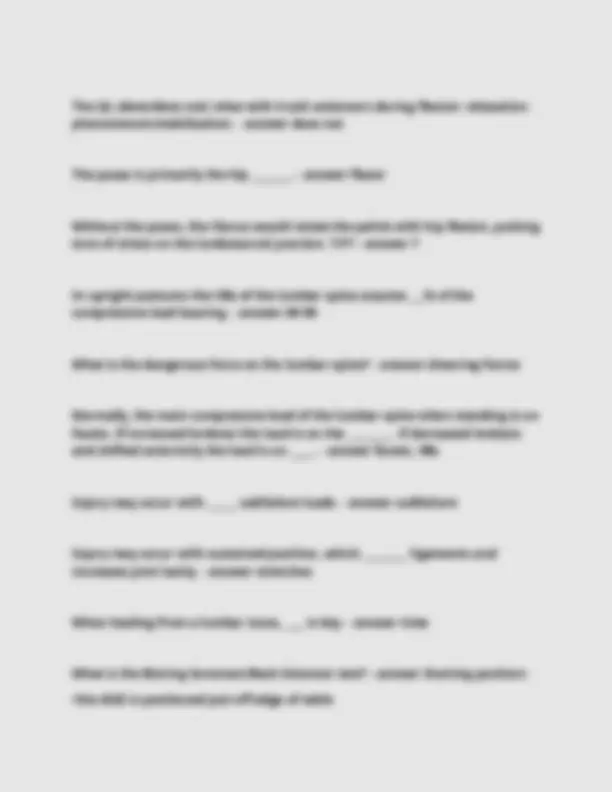
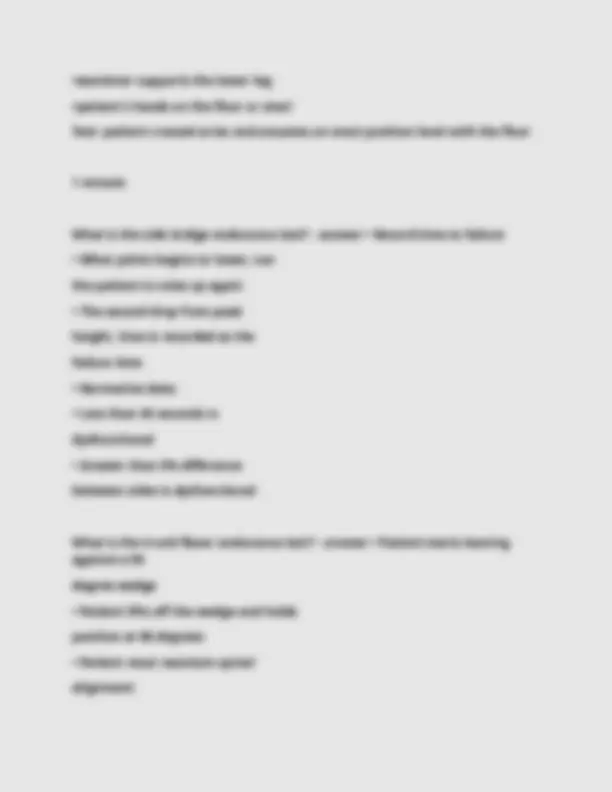
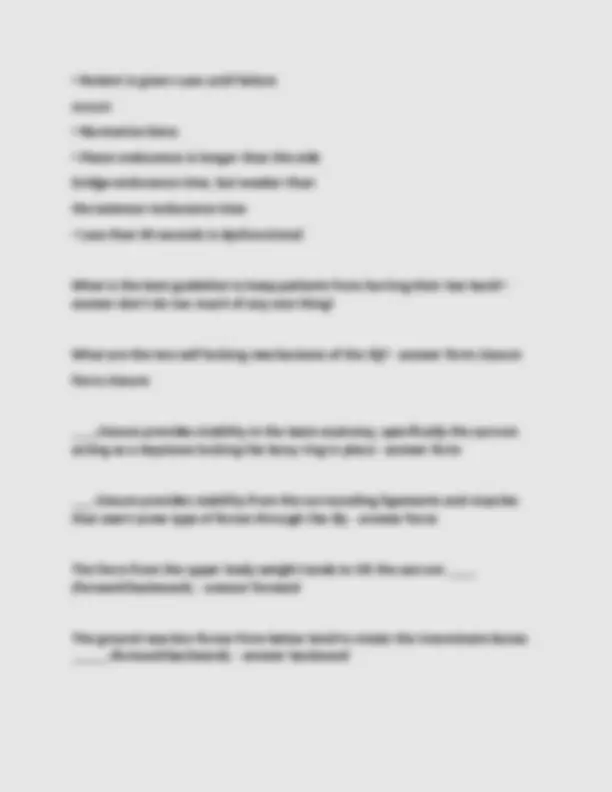


Study with the several resources on Docsity

Earn points by helping other students or get them with a premium plan


Prepare for your exams
Study with the several resources on Docsity

Earn points to download
Earn points by helping other students or get them with a premium plan
Community
Ask the community for help and clear up your study doubts
Discover the best universities in your country according to Docsity users
Free resources
Download our free guides on studying techniques, anxiety management strategies, and thesis advice from Docsity tutors
NWHSU Methods 2 Final Lecture Exam questions and answers.docx
Typology: Exams
1 / 11

This page cannot be seen from the preview
Don't miss anything!







The saggital plane alignment of the facets favors ___________ and greatly limits _______. - answer flexion/extension, rotation In the lumbar spine, the normal disc spaces are (larger/smaller) than those of the thoracic spine. This contributes to the relatively large arc of motion that is possible in the lumbar spine. - answer larger The general direction of the facet planes in the lumbar spine is (parallel/horizontal) to the sagittal plane;
Anterior translation is limited by the bony geometry of the ________. Anterior rotation is limited by tension in the __________. - answer facet joints, posterior anulus fibrosis and PLLs In extension, each vertebrae rotates ________ and also has a posterior ________. - answer posteriorly, translation Lumbar extension is limited by the approximation of the ____________ and the spinous processes. - answer articular processes More lumbar rotation occurs at the _____ segment. - answer L5-S Why is rotation restricted in the lumbar spine? - answer the sagittal plane alignment, because rotation is transverse Tension in the intertransverse ligament and the capsule of the contralateral facet joint and approximation of the ipsilateral facet joint surfaces all act to restrict ___________. - answer side bending aka lateral flexion When the lumbar spine is in a position of lateral flexion, rotation is greater to the opposite side (toward the convexity) than to the same side. T/f? - answer T
What is an example of asymmetrical SIJ motion? - answer one legged squat or one legged stance while walking Flexion of the trunk from standing combines flexion of the lumbar vertebrae with forward __________ of the pelvis on the fixed femora. - answer rotation When performing multi segmental flexion the pation should keep legs straight and.... - answer bend forward to touch toes, looking for hips to move backwards Extension of the trunk from standing combines extension of the lumbar vertebrae with posterior ________ of the pelvis on the fixed femora - answer rotation When doing multi segmental extension the patient raises arms and extends backwards, with the scapula.... - answer clearing the heels and ASIS staying in front of the toes Motion changes foramen _________. - answer diameter The lumbar spine has quite large foramen diameters when compared with the size of the ______. When flexing and extending the space decreases 20-30% - answer nerves- diameter is 16x21 mm with nerves being 10mm The intervertebral discs are ________ (no blood supply.) - answer avascular Dinural disc height is... - answer The phenomenon that discs gain more water with reduced loaded with sleeping/laying down, causing people to grow up to 2cm taller!
The nucleus pulposus deforms in the (direction or opposite direction) to the motion. - answer opposite direction Though the disc is elastic, it is much less able to tolerate ________ forces because during this a portion of the fibers are not under tension so it's not all being used to resist the stress. - answer torsional/rotational What is the most common mechanism of disc injury? - answer a common mechanism of disc injury is combined rotational and forward-bending movements The three primary ways in which an abnormal IVD may cause symptoms are: - answer 1- direct injury to outer anulus fibrosis 2- herniated disc 3- degenerative disc Spinal ligaments are relatively ________. (elastic/inelaastic) - answer inelastic An increase in the sacral inclination along with a decrease in the lumbosacral angle necessitates an increase in the lumbar _______. - answer lordosis- an anteroinferior shear stress is produced at the L5-S1 junction; Subsequently, L5 tends to slide forward on the sacral promontory
thoracic, lumbar, and sacral vertebrae and covers the erector spinae muscles. Laterally, it blends with the latissimus dorsi muscle, and inferiorly it blends with the gluteus maximus muscle, thus forming a direct connection between the proximal humerus and proximal femur The TLF (thoracolumbar fascia) provides dynamic stabilization between the spine and the _______________. This is especially helpful in lifting and flexing. - answer deep abdominals Strength = _________ - answer stability What is the interesting thing rotatores and intertransversarii muscles do? - answer are involved as length transducers or vertebral position sensors at every thoracic and lumbar joint The longissimus and iliocostalis are the major ________ of the thoracolumbar spine. - answer estensors The multifidus muscles only affect local areas of the spine, and help with _____ torque. - answer extensor The abdominals are involved in twisting and lateral bending, along with increasing intraabdominal pressure, which is __________.. - answer strategic in stabilizing the low back The QL is active during what motions? - answer All of them but rotation
The QL (does/does not) relax with trunk extensors during flexion- relaxation phenomenon/stabilization. - answer does not The psoas is primarily the hip ________. - answer flexor Without the psoas, the iliacus would rotate the pelvis with hip flexion, putting tons of stress on the lumbosacral junction. T/F? - answer T In upright postures the VBs of the lumbar spine assume ___% of the compressive load bearing. - answer 80- What is the dangerous force on the lumbar spine? - answer shearing forces Normally, the main compressive load of the lumbar spine when standing is on facets. If increased lordosis this load is on the _________. if decreased lordosis and shifted anteriorly the load is on _____. - answer facets, VBs Injury may occur with ______ subfailure loads. - answer subfailure Injury may occur with sustained position, which _________ ligaments and increases joint laxity. - answer stretches When healing from a lumbar issue, ____ is key. - answer time What is the Biering Sorensen/Back Extensor test? - answer Starting position- •the ASIS is positioned just off edge of table
What muscles make up the floor of the spinal stabilization system? - answer pelvic floor muscles Most structures exiting the pelvic cavity pass through the _________, along with the piriformis. - answer greater sciatic foramen